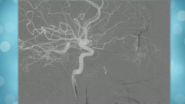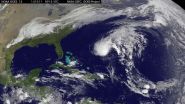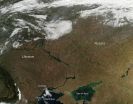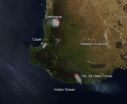(Press-News.org) First-hand experience of extreme weather often makes people change their minds about the realities of climate change. That's because people are simply more aware of an extreme weather event the closer they are to its core, and the more intense the incidence is. So says Peter Howe of Utah State University in the US, who led a study in Springer's journal Climatic Change Letters about people's ability to accurately recall living through extreme weather events. It also focused on how people's proximity to such events – the so-called "shadow of experience" – aids their awareness of climatic episodes.
Howe's team mapped data on people's extreme weather perceptions from a national survey of 1,008 US adults conducted by the Yale Project on Climate Change Communication and George Mason Center for Climate Change Communication. The data were then overlaid on other maps of actual recorded events such as droughts, hurricanes and tornadoes.
They found that the public tends to accurately recall and report on extreme weather conditions. This is particularly true for hurricanes and tornadoes that cause large-scale destruction and personal suffering as well as events that attract media coverage. Drought, on the other hand, is much more difficult to perceive because it happens slowly over a longer period of time. It also generally affects a larger area of land. Actually, most people only believe that they have experienced a drought after 25 weeks of persistently dry conditions.
The closer people were to a weather event, the more intense and destructive it was and the longer it lasted, the better are the chances that people will note it. Howe says the proximity effect may be explained by an increased likelihood of personally suffering harm or property damage as one approaches the site of the event, as well as environmental cues (such as dark clouds or high winds) and social cues (such as tornado sirens or warnings).
"The shadow of experience – or the area within which people are more likely to report that they have experienced extreme events – increases as the magnitude of an event increases," explains Howe. "Indirect damage through disruption of services, utilities, businesses, social networks, and local economies are one likely cause for the tendency of people to report personally experiencing events even if they live many kilometers away and did not suffer direct personal damage."
Howe and his team believe that maps showing the shadows of experience of extreme weather could be used to focus disaster preparedness and climate education efforts after an event. They advise weathercasters to provide more climate change context when extreme weather events happen, and to educate their viewers about the climatic reasons behind them. In the case of droughts, the public should be helped to recognize the phenomenon as it is happening and to take specific steps to deal with it.
INFORMATION:
Reference: Howe, P.D. et al (2014). Mapping the shadow of experience of extreme weather events, Climatic Change Letters. DOI 10.1007/s10584-014-1253-6
Teachable moments about climate change
Mapping first-hand experience of extreme weather conditions helps to target climate education efforts
2014-10-14
ELSE PRESS RELEASES FROM THIS DATE:
New 'tree of life' traces evolution of a mysterious cotinga birds
2014-10-14
Ithaca, N.Y.—They are some of the brightest, loudest, oddest-looking, least-understood birds on the planet. Some have bulbous crests, long fleshy wattles, or Elvis-worthy pompadours in addition to electric blue, deep purple, or screaming orange feathers. But thanks to a comprehensive new evolutionary "tree of life" generated for the tropical cotinga family of South America, the door is now open to new discoveries about the more than 60 species in this amazingly diverse group of birds.
"Our study provides comprehensive insight into how nearly all the cotinga species ...
Current models for predicting outcomes after mild traumatic brain injury perform poorly
2014-10-14
New Rochelle, NY, October 14, 2014—For the 5-15% of patients with mild traumatic brain injury (mTBI) who will have lingering physical, behavioral, or cognitive problems 3 to 6 months after their injury, identification of this at-risk population is essential for early intervention. Existing models used to predict poor outcomes after mTBI are unsatisfactory, according to a new study, and new, more relevant predictive factors are different than those used in cases of moderate or severe TBI, as described in the study published in Journal of Neurotrauma, a peer-reviewed ...
New treatment designed to save more eyes from cancer
2014-10-14
VIDEO:
Some children with advanced retinoblastoma are not good candidates for conventional intraocular ophthalmic infusion therapy -- too often making removal of the eye the only viable treatment for saving their...
Click here for more information.
CINCINNATI – Doctors at Cincinnati Children's Hospital Medical Center have developed a new technique for treating the eye cancer retinoblastoma to improve the odds for preventing eye loss, blindness or death in children with ...
NASA sees Hurricane Gonzalo head toward Bermuda
2014-10-14
Tropical Storm Gonzalo intensified into a hurricane late on Monday, Oct. 14 and is expected to become a major hurricane as it moves toward Bermuda. NASA's Aqua satellite saw powerful thunderstorms within the center of the storm that were dropping heavy rainfall.
At 5 pm EDT, on Oct. 13 Gonzalo had become a hurricane. At that time, the center of the storm was just 20 miles southeast of St. Martin. The National Hurricane Center (NHC) noted that maximum sustained winds had increased to near 75 mph (120 kph) and additional strengthening was forecast. Gonzalo continued moving ...
Discovery of the Benešov meteorites 20 years after the bolide event
2014-10-14
Astronomy & Astrophysics is publishing the spectacular discovery of meteorite fragments 20 years after the corresponding bolide was seen in the skies of the Czech Republic. This discovery was made possible by reanalyzing the trajectory, which moved the impact line by 330 meters. Interestingly, the meteorites found on the ground are of different types, pointing to a parent asteroid of heterogeneous composition.
Collisions of meter-sized meteoroids with the Earth's atmosphere are relatively rare, occurring about 40 times a year. They cause very spectacular events, known ...
Unique catalysts for hydrogen fuel cells synthesized in ordinary kitchen microwave oven
2014-10-14
Swedish and Chinese researchers show how a unique nano-alloy composed of palladium nano-islands embedded in tungsten nanoparticles creates a new type of catalysts for highly efficient oxygen reduction, the most important reaction in hydrogen fuel cells. Their results are published in the scientific journal Nature Communications.
The world's rapidly growing demand for energy and the requirement of sustainable energy production calls for an urgent change in today's fossil fuel based energy system. Research groups worldwide work intensively to develop novel advanced energy ...
Fires dot the Ukraine countryside
2014-10-14
Numerous fires (marked with red dots) are burning in the Ukraine, likely as a result of regional agricultural practices. The body of water at the lower left of this true-color Moderate Resolution Imaging Spectroradiometer (MODIS) image is the Sea of Azov. The Sea is bordered by Ukraine to the northwest, west and southwest and by Russia to the northeast, east, and southeast. To its left is the Black Sea.
The location, widespread nature, and number of fires suggest that these fires were deliberately set to manage land. Farmers often use fire to return nutrients to the soil ...
Prescribed burns in Western Australia
2014-10-14
The Moderate Resolution Imaging Spectroradiometer (MODIS) on NASA's Aqua satellite detected fires burning in Western Australia on October 14, 2014. Matching these hot spots up to the the prescribed fire burns on Western Australia's parks and wildlife site: http://www.dpaw.wa.gov.au/management/fire/prescribed-burning/burns these fires are most likely prescribed burns used to limit bushfire outbreaks. According to the Government of Australia's Department of Parks and Wildlife, "Prescribed burning is the process of planning and applying fire to a predetermined area, under ...
Early detection window when pancreatic cancer is in the family
2014-10-14
Pancreatic cancer likely takes between 10 and 20 years to develop, providing the potential for a very "broad window" of intervention if detected early, which may be possible for people who inherit a predisposition, say Australian clinical researchers.
Dr Jeremy Humphris and Professor Andrew Biankin1, from Sydney's Garvan Institute of Medical Research, analysed medical histories and tumour samples taken from a cohort of 766 pancreatic cancer patients, operated on between 1994 and 20122. Roughly 9% of these patients had a first-degree relative (parent or sibling) with ...
Seniors run for the suburbs in their golden years
2014-10-14
Montreal, October 14, 2014 — By 2040, there will be more than three times the number of Americans aged 80+ than there were in 2000. Condo towers crowding city skylines seem to reflect builders' hopes that the grey set will head to urban centres for increased services and better transit options. But new research from Concordia University suggests that the opposite is more likely to occur.
In a study recently published in the Journal of Transport Geography, researcher Zachary Patterson uses census data to map seniors' moving habits. What emerges is a clear pattern: ...
LAST 30 PRESS RELEASES:
Deepest gas hydrate cold seep ever discovered in the arctic: International research team unveils Freya Hydrate Mounds at 3,640 m depth.
Integrating light and structure: Smarter mapping for fragile wetland ecosystems
ACA-SIM: A robust way to decode satellite signals over complex waters
Probiotics can restore gut microbiome in breastfed infants
AI could help predict nutrition risks in ICU patients, study finds
Federal EITC has unexpected result, researchers say – it decreases domestic violence
Researchers identify gene that calms the mind and improves attention in mice
Artificial metabolism turns waste CO2 into useful chemicals
Ancient sea anemone sheds light on animal cell type evolution
Begging gene leads to drone food
How climate policies that incentivize and penalize can drive the clean energy transition
Can community awareness campaigns in low-resource areas improve early diagnosis of colorectal cancer?
Stardust study resets how life’s atoms spread through space
Practical education: Clinical scenario-based program development
The impact of family dynamics on eating behaviour – how going home for Christmas can change how you eat
Tracing the quick synthesis of an industrially important catalyst
New software sheds light on cancer’s hidden genetic networks
UT Health San Antonio awarded $3 million in CPRIT grants to bolster cancer research and prevention efforts in South Texas
Third symposium spotlights global challenge of new contaminants in China’s fight against pollution
From straw to soil harmony: International team reveals how biochar supercharges carbon-smart farming
Myeloma: How AI is redrawing the map of cancer care
Manhattan E. Charurat, Ph.D., MHS invested as the Homer and Martha Gudelsky Distinguished Professor in Medicine at the University of Maryland School of Medicine
Insilico Medicine’s Pharma.AI Q4 Winter Launch Recap: Revolutionizing drug discovery with cutting-edge AI innovations, accelerating the path to pharmaceutical superintelligence
Nanoplastics have diet-dependent impacts on digestive system health
Brain neuron death occurs throughout life and increases with age, a natural human protein drug may halt neuron death in Alzheimer’s disease
SPIE and CLP announce the recipients of the 2025 Advanced Photonics Young Innovator Award
Lessons from the Caldor Fire’s Christmas Valley ‘Miracle’
Ant societies rose by trading individual protection for collective power
Research reveals how ancient viral DNA shapes early embryonic development
A molecular gatekeeper that controls protein synthesis
[Press-News.org] Teachable moments about climate changeMapping first-hand experience of extreme weather conditions helps to target climate education efforts





